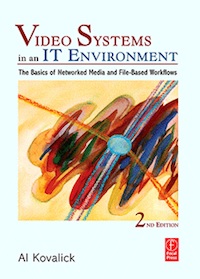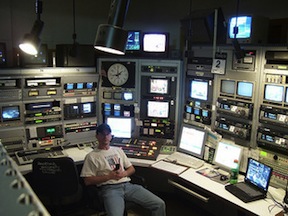< Back to all posts
Working at the Intersection of A/V & IT
It’s official. Audio/Video (A/V) systems and Information Technology (IT) have collided. Worldwide, A/V professionals and camera crews are being impacted by the transition to IT components and file-based techniques.
 The good news is that we now have a guide to help us navigate our way through these new technologies: “The AVIT Book,” by former Hewlett-Packard digital systems strategist Al Kovalick.
The good news is that we now have a guide to help us navigate our way through these new technologies: “The AVIT Book,” by former Hewlett-Packard digital systems strategist Al Kovalick.
A true bestseller in the media industry, his expanded second edition includes the basics of networked media, storage systems for A/V, descriptions of MXF and other file formats, Web services and SOA, software platforms, data center virtualization, 14 methods for high-availability design, and more.
So we were excited to interview Kovalick to learn about best practices, and the processes and principles of seamless AV/IT systems integration. Scroll down for our Q&A.
Andrea Keating: Professionals in the video industry are often experts at A/V. While many are quick to pick up the IT aspects of the business, we would all love to learn more about how to manage the AV / IT convergence. What are your top three suggestions?
Al Kovalick: First, become very familiar with IT terms and concepts, especially related to connectivity choices, media transfers, basic protocol operations (such as IP, TCP, UDP, Ping, RTP, DHCP), and security. Second, understand the basics of file transfer, steaming transfer, and storage access. These three forms of media movement are the basics of media in an IT world. Finally, become familiar with what the cloud can offer in terms of storage, processing, and apps. Appreciate the tradeoffs that the cloud offers, and use it where it makes sense.
Andrea Keating: Given those suggestions, what is the biggest hurdle that A/V professionals face? 
Al Kovalick: Moving from the comfort zone of A/V to that of IT + A/V. A/V is what we do, and IT seems a sideshow to some. However, the smart operator knows that “things happen,” and knowledge of what IT can and can’t do may mean the difference between a successful camera shoot and a failure.
Andrea Keating: What is the biggest challenge for IT professionals?
Al Kovalick: Keeping up with the landslide of new IT capabilities. IT is more fluid than A/V in many ways, and new standards are coming on the scene every day. Of course, not all of these will impact our business, but some will. The smart operator keeps on top of the new trends.
Andrea Keating: What are some of the hottest trends in the AV / IT convergence?
Al Kovalick: Dare I say the word “cloud” without sounding pedestrian? Its values are quickly becoming apparent to many in our field. One of the biggest advantages is common (shared) storage. With universal access and “in the cloud” A/V processing, A/V clips can be processed and up/downloaded as needed. Vendors are staring to offer cloud-based apps that run in Web browsers with amazing performance and features. Recent announcements have demo’d video editing in the cloud with performance equal to installed professional apps. Another trend is the transition to “Ethernet everywhere” for moving A/V. Sure, Ethernet and some wireless moves files today. But the horizon is showing signs of traditional video links being replaced by Ethernet. Expect Ethernet ports on cameras for file and stream outputs.
Andrea Keating: When I think about this, webcasting, virtual trade shows, and souped-up webinars come to mind. Are these cutting-edge trends, or passé
Al Kovalick: Let’s distinguish between production technology and that used for distribution. Distribution, in some of the examples you cite, is mature and expanding in use and using IT to good effect. Production technology is more demanding; not so much in scale but in quality, reliability, and performance. Production can’t tolerate errors, poor connectivity, or reduced quality. Don’t let anyone tell you that traditional A/V is more reliable than IT. Do you think for a moment that Google, Ebay, Twitter, or Facebook don’t care about uptime? Our business is learning from the big IT masters and borrowing ideas for our needs. Bottom line, we are in the final transition to all-IP connectivity and all-IT systems.
Andrea Keating: Will some of the new technologies force a few of our favorite tools out to pasture? For instance, what will become of Final Cut Pro?
Al Kovalick: Looking down the road, I can imagine many video tools being cloud-based. Who among us doesn’t want instant access to our projects from anywhere? Or Web apps that run as fast as those locally installed? Or, universal storage access to media and metadata? Or apps that are upgraded in the background? The list goes on. The smart vendors see this trend and are planning for it. However, some of your readers may be thinking, “I work in the field without convenient Internet access; this guy is nuts.” Sure, there are some cases where installed apps will have a place. Still, the overwhelming trend is to leverage IT and cloud where possible. Even for cases where Internet access is problematic, once the shoot is complete, post-production actions may well have a cloud component.
Andrea Keating: What else do we need to know? Or should we be afraid to ask?
Al Kovalick: Good question. Read, stay on top of the convergence of A/V + IT. Experiment! Try new things and get your feet wet with new technology. Subscribe to bloggers, twitters, and newsletters that expand your knowledge. At the very least, know what you don’t know, and possibly you will win out against someone who does not know what they do not know.
Andrea Keating: Thank you so much for taking the time to talk to us, Al! We appreciate your insights.
Inside the AV/IT Book
In his book, “Video Systems in an IT Environment,” author Al Kovalick gives us insight into these 12 topics that we need to know about:
- Networked Media in an IT Environment
- The Basics of Professional Networked Media
- Storage System Basics
- Storage Access Methods
- Software Technology for A/V Systems
- Reliability and Scalability Methods
- Networking Basics for A/V
- Media Systems Integration
- Security for Networked A/V Systems
- Systems Management and Monitoring
- The Transition to Tapeless: Issues and Case Studies
- A Review of A/V Basics
For more information, visit theavitbook.com.







Leave a Reply